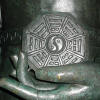|
trigram
Symbol indicating the eight points of the
compass used by geomancers. Each trigram consists of a different
combination of three lines which may be broken in the middle. A
broken line represents
yin,
and unbroken line
yang. When
used for divination or fortune telling the trigram is arranged
in a circle with
yin-yang signs in the middle,
or ‒as on the shi pan
(式盤), circular cosmographic
divination boards‒
with Chinese
characters (fig.) representing the 36 animals thought to
have jurisdiction over the hours of the day and the
Twenty-eight Lunar Mansions
or
28 Moon Lodges
of the 28 Celestial Deities in the Star
Mandala. When using the
eight possible combinations of trigrams, they may represent
directions, animals, body parts, natural elements, states, a family
member, as well as a binary value, which is equal to the number one
for an unbroken yang-line and zero for a
broken yin-line. In addition, they represent other attributes
and characteristics, which are used in fortunetelling, in a way
similar to the use of an horoscope. The eight possible combinations
of trigrams and their representations are:
☰
Northwest, heaven,
dragon, strong,
creative, father and head;
☵
North, water,
pig,
dangerous, in-motion, second son and ears;
☷
Southwest, earth, cow, devoted, receptive, mother and belly;
☲
South, fire, pheasant, light-giving, clinging, second daughter and
eye;
☴
Southeast, wind, fowl, penetrating, gentle, first daughter and
thigh;
☱
West, marsh, sheep, pleasure, tranquil, third daughter and mouth;
☳
East, thunder, horse, inciting, initiative, first son and foot;
☶
Northeast, mountain, wolf, stand-still,
completion, third son and hand. These combinations of lines can be
arranged in any order, which may be according to their corresponding
wind direction, but often with the trigram of three unbroken lines,
which represent Heaven, opposite the three broken lines, that
represent Earth. Trigrams can often be seen as a
decoration on buildings, furniture, textiles and ceramic products,
and four
trigram figures, namely the ones
representing Heaven, Water, Earth and Fire,
are shown on the flag of South Korea.
In Chinese, it is called
gua (trigram) or
bagua (eight trigrams),
while in Thai, it is known as
yan paet thit,
i.e.
‘magic sign of the eight directions’. Bagua mirrors,
i.e. round mirrors that are either accompanied by or surrounded a trigram
(fig.), are a popular
symbol in
feng shui. They are placed at doorways
as a protective charm, to bring luck or to keep evil spirits out.
While the bagua mirror originated in
China, practices with a similar
principle are also found in other parts of the world, such as the
mirrors placed above doorways of
old buildings in India (fig.).
Pan Gu,
the cosmic giant of Chinese myth, is sometimes portrayed holding a
trigram as
attribute
(fig.).
See also
I
Ching.
回






|

